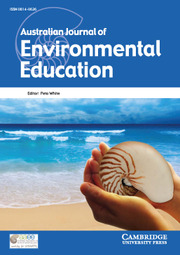Practitioner statement
This slice of life perzine was created to model the lo-fi storytelling that can be brought into the classroom (Figure 1). Students can fold a page and use their choice of multimedia expression to tell their story and imagined future. The perzine is inclusive with unlimited communication formats and focus on self-expression (Martin, Reference Martin2020). This activity is designed to build on speculative methods in education discussed by Truman (Reference Truman2023) could provide permission to imagine an alternate future, working.
There is a long tradition of zines in education, (Ross & Pears, Reference Ross and Pears2022). However it is the contention of if it maintains its counter culture integrity when prescribed in an education setting that is the reason that it is well places to support young people in expressing and building their biospheric values. Young people are more responsive when pro-environment behaviours are framed as voluntary and rebellious (van de Wetering et al., Reference van de Wetering, Grapsas, Poorthuis and Thomaes2025). The activity could complement students’ analysis of solar punk texts. This approach could lead to student led conversations about climate (Balundė et al., Reference Balundė, Perlaviciute and Truskauskaitė-Kunevičienė2020).

Figure 1. Harri’s Guide to Hippiness in Apocalyptic Heat, 2025.
Acknowledgements
None.
Financial support
No funding was received for this project.
Ethical standards
All characters and events depicted are entirely fictitious. Informal concent and ethics processes were used in this authoethnographic research.
Author Biography
Claire Bowmer is an instructional designer and teacher educator. She delivers media and expressive arts workshops for preservice teachers at Flinders University. This has included using zines and reflective art for learning and introducing challenging topics of sustainability. She remains connected to education through delivering creative workshops in schools from nature journaling and sketch note-taking to AI for imagining futures. She shares both her professional design career experience and more illustration practice of telling stories in comics and picture books under Claire Richards. She has volunteered with the SA chapter of Australian Association of Environmental Educators to develop resources linked with art and story telling. Claire has a Master of Education degree and is continuing to study sustainability at UTAS.



